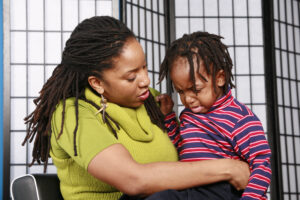
Learning to Tolerate Frustration and Delay Gratification
It’s hard to wait! It can be hard for adults, and it’s even harder for young children. Psychologist Walter Mischel and colleagues have spent decades
Almost 50 years ago, researchers Alexander Thomas and Stella Chess studied 100 babies from early infancy to adulthood and identified 9 temperament traits, including persistence, intensity of reaction, activity level, and adaptability. Since that time, scientists have been able to refine our understanding and focus on five qualities of temperament, which the Program for Infant/Toddler Care describe as:
1. Activity level: a person’s typical speed and intensity of movement.
→ Do you or your child find it difficult to sit still, or find yourselves drawn to quieter activities?
2. Reaction to the unexpected: a person’s cautiousness or distress in response to unfamiliar people, places or things.
→ Do you or your child approach new people or situations with caution, or even distress?
3. Attention and regulation: a person’s usual level of ability to regulate or manage their emotions, energy level and attention.
→ Is it hard to focus on one thing at a time…or is moving on from an engaging activity the hard part?
4. A person’s tendency to experience anger, irritability and frustration
→ Are you or your child often challenged by feeling angry, irritable or frustrated?
5. A person’s tendency to experience exuberance, enthusiasm, and cheerfulness
→Are you or your child pretty likely to be joyful or content at any given moment?
A person’s temperament may be higher or lower in any of these qualities.
In addition, our emotional tendencies can be described in terms of:
For example:
Evan is high in intensity, and low in threshold, and high in duration typical experiences of anger, irritability and frustration: when he gets mad, he gets very mad, it doesn’t take much to anger them, and he needs lots of time to cool down. (See tips for supporting a child in learning to self-regulate.)
Nola, on the other hand, is also high in intensity and low in threshold for those same difficult feelings, but she’s also low in duration: she upsets easily, and her frustration is intense, but she tends to bounce back quickly.
What’s more, these emotional tendencies may be different for positive and negative emotions! Put all this together, and it’s clear that each of our children, and all adults too, are truly unique combinations of temperament tendencies.
Our temperament tendencies influence the way we interact with other people and the world around us. Seeing how our child’s temperament “fits” their environment is the next step toward supporting our child’s capacity to thrive.

It’s hard to wait! It can be hard for adults, and it’s even harder for young children. Psychologist Walter Mischel and colleagues have spent decades

All relationships experience moments of miscommunication or conflicting intentions and expectations; these are known as ruptures. No matter how good a parent you are – no

Young children must find their own space and place – physically and emotionally – in their homes and in the world. To do this, they

As parents, we get so much feedback about what we can do to enhance our baby’s development. Sometimes, it can be difficult to remember one

Children thrive when they are provided with a predictable, structured environment. Routines provide a sense of safety and security, as well as foster healthy emotional and

Just think of how much time babies spend in routines of one kind or another: sleeping, bathing, feeding, and diaper changing, not to mention dressing,

An excerpt from a behind-the-scenes interview with Dr. Kathy Hirsh-Pasek at the 2018 Simms/Mann Institute Think Tank

As parents, we get so much feedback about what we can do to enhance our baby’s development. Sometimes, it can be difficult to remember one
| Cookie | Duration | Description |
|---|---|---|
| __stripe_mid | 1 year | Stripe sets this cookie cookie to process payments. |
| __stripe_sid | 30 minutes | Stripe sets this cookie cookie to process payments. |
| cookielawinfo-checkbox-advertisement | 1 year | Set by the GDPR Cookie Consent plugin, this cookie is used to record the user consent for the cookies in the "Advertisement" category . |
| cookielawinfo-checkbox-analytics | 11 months | This cookie is set by GDPR Cookie Consent plugin. The cookie is used to store the user consent for the cookies in the category "Analytics". |
| cookielawinfo-checkbox-functional | 11 months | The cookie is set by GDPR cookie consent to record the user consent for the cookies in the category "Functional". |
| cookielawinfo-checkbox-necessary | 11 months | This cookie is set by GDPR Cookie Consent plugin. The cookies is used to store the user consent for the cookies in the category "Necessary". |
| cookielawinfo-checkbox-others | 11 months | This cookie is set by GDPR Cookie Consent plugin. The cookie is used to store the user consent for the cookies in the category "Other. |
| cookielawinfo-checkbox-performance | 11 months | This cookie is set by GDPR Cookie Consent plugin. The cookie is used to store the user consent for the cookies in the category "Performance". |
| CookieLawInfoConsent | 1 year | Records the default button state of the corresponding category & the status of CCPA. It works only in coordination with the primary cookie. |
| elementor | never | This cookie is used by the website's WordPress theme. It allows the website owner to implement or change the website's content in real-time. |
| viewed_cookie_policy | 11 months | The cookie is set by the GDPR Cookie Consent plugin and is used to store whether or not user has consented to the use of cookies. It does not store any personal data. |
| Cookie | Duration | Description |
|---|---|---|
| mailchimp_landing_site | 1 month | The cookie is set by MailChimp to record which page the user first visited. |
| Cookie | Duration | Description |
|---|---|---|
| _ga | 2 years | The _ga cookie, installed by Google Analytics, calculates visitor, session and campaign data and also keeps track of site usage for the site's analytics report. The cookie stores information anonymously and assigns a randomly generated number to recognize unique visitors. |
| _gat_gtag_UA_46801669_2 | 1 minute | Set by Google to distinguish users. |
| _gid | 1 day | Installed by Google Analytics, _gid cookie stores information on how visitors use a website, while also creating an analytics report of the website's performance. Some of the data that are collected include the number of visitors, their source, and the pages they visit anonymously. |
| tk_lr | 1 year | The tk_lr is a referral cookie set by the JetPack plugin on sites using WooCommerce, which analyzes referrer behaviour for Jetpack. |
| tk_or | 5 years | The tk_or is a referral cookie set by the JetPack plugin on sites using WooCommerce, which analyzes referrer behaviour for Jetpack. |
| tk_r3d | 3 days | JetPack installs this cookie to collect internal metrics for user activity and in turn improve user experience. |
| tk_tc | session | JetPack sets this cookie to record details on how user's use the website. |
| Cookie | Duration | Description |
|---|---|---|
| cookies.js | session | No description available. |
| m | 2 years | No description available. |